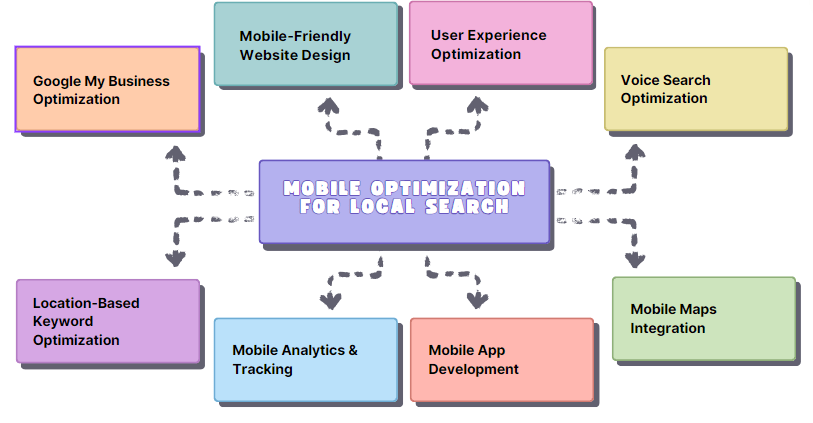The objective of local search engine optimization or SEO is to increase a company’s exposure to local search engine results. It attempts to link local companies with clients who are looking for goods or services on the Internet. Businesses can raise their ranks in local search results by optimizing different facets of their websites and online presence, such as local keywords, Google My Business listings, and online reviews. Businesses that target local customers, such as brick-and-mortar stores and service providers, can greatly benefit from local SEO. It makes companies stand out in the neighbourhood, attract customers to their physical locations, and eventually boost revenue and sales.
Mobile devices are now the main tool used by customers looking for local businesses and services in the digital age. Mobile optimization for local searches is essential for companies trying to draw in customers who are always on the go and get visitors to their physical locations. Companies are able to increase their exposure in local search results and give mobile users an effortless visit by making sure their websites and online presence are optimized for mobile devices. The significance of mobile optimization for local searches is examined in this introduction, which also identifies important tactics that companies can use to enhance their mobile presence and generate interest in local clients.
What is a local mobile search?
Local mobile search is the process of looking up information about companies, goods, or services in a particular area using mobile devices like tablets or smartphones. It entails searching local directories, map applications, or search engines to find businesses in the area, get directions to physical locations, get contact details, or read reviews. For customers who are constantly on the go and seeking nearby solutions or services, local mobile search is especially important. In order to increase their visibility and attract local clients, businesses can enhance their online presence to make sure they show up prominently in local mobile search results.
How do I optimize websites for local mobile search?
Mobile Optimization for Local Searches

Importance of mobile-friendly websites for local SEO
Nowadays, businesses need to put a higher demand on creating mobile-friendly websites due to the increase of smartphones and other mobile devices. The ability of mobile-friendly websites to accommodate the increasing number of mobile users When consumers look for nearby companies and services using their smartphones and tablets, it makes them crucial for local SEO.
Here’s the reason why local SEO requires mobile friendliness
Mobile user experience and its impact on local search rankings
Local search rankings are greatly influenced by mobile user experience (UX) in today’s digital environment. Websites that are mobile- and user-friendly are favored by search engines as more people conduct their online searches on mobile devices. Companies trying to increase their internet presence and generate local clients must comprehend how mobile user experience affects local search rankings.
Here’s the some simple steps that how mobile user experience and its impact on local search rankings
Conclusion
In the current digital era, mobile optimization for local searches is not only a trend but also a need. Businesses can no longer afford to undervalue the significance of offering a perfect mobile experience, given that mobile devices are used by the majority of internet users to obtain information. Companies may increase their local search engine ranks and attract more customers by emphasizing user-centric design, local keyword optimization, and mobile responsiveness. Adopting mobile optimization is essential for maintaining competitiveness as well as for providing outstanding experiences that generate tangible outcomes and create enduring relationships with regional audiences.
FAQ’s
Why is mobile optimization important for local businesses?
Mobile optimization is essential for local businesses as a significant portion of consumers use mobile devices for browsing. It guarantees that websites load swiftly, are simple to navigate, and offer a flawless user experience on tablets and smartphones. By accommodating mobile users, businesses may efficiently communicate and engage with their intended audience, which will ultimately increase customer satisfaction, visibility, and conversion rates.
What are the key components of mobile optimization for local searches?
The implementation of structured data markup, responsive design for cross-device compatibility, accurate Google My Business (GMB) listing with location details, localized content integration, quick loading times, and user-friendly features like click-to-call options and mobile-specific navigation menus are all essential elements of mobile optimization for local searches.
How does Google My Business (GMB) optimization impact local mobile searches?
Local mobile searches are positively impacted by Google My Business (GMB) optimization, as it guarantees that businesses are displayed prominently in search results. Mobile users can easily find and find businesses with optimized, accurate GMB listings as they are clearly displayed on Google Maps and in local search results. Higher conversion rates from mobile searches result from this as it raises click-through rates and encourages foot traffic to physical locations.
What are the best practices for optimizing a website for mobile users?
Local mobile searches are positively impacted by Google My Business (GMB) optimization, as it guarantees that businesses are displayed prominently in search results. Mobile users can easily find businesses with optimized, accurate GMB listings as they are clearly visible in local search results and on Google Maps. Higher conversion rates from mobile searches result from this as it raises click-through rates and encourages foot traffic to physical locations.
How can local businesses improve their mobile loading speed?
Local businesses can use browser caching to store frequently accessed resources, reduce HTTP requests by combining CSS and JavaScript files, and optimize images and multimedia delivering material via content delivery network (CDN) files in order to minimize file size content from servers closer to users, enable compression for text-based resources, and prioritize above-the-fold content to load first in order to improve mobile loading speed. Mobile loading speed can also be improved by decreasing server response times and using Google’s Page Speed Insights tool to find and fix performance issues.

